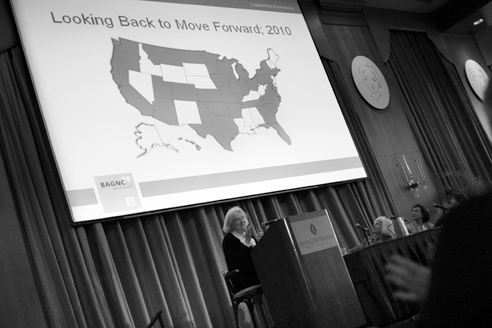http://www.geriatricnursing.org
Building Academic Geriatric Nursing Capacity (BAGNC) Initiative 10th Anniversary
Quality Nursing Care Depends on Education, Research, and Leadership
When the John A. Hartford Foundation began funding geriatric nursing initiatives in 1996, there simply were not enough academic nurses specializing in geriatrics to educate the next generation and to engage in the research needed to develop and test the best models of care for older patients. Geriatric nursing suffered from negative perceptions among both the public and health professionals.
 Dr. Claire Fagin addressing the 2010 BAGNC Leadership Conference.
Dr. Claire Fagin addressing the 2010 BAGNC Leadership Conference.
At that time, less than one percent of the 2.2 million practicing registered nurses were certified in geriatrics; less than .002 percent of registered nurses were geriatric nurse practitioners or clinical nurse specialists; only 23 percent of nursing schools had a required course in geriatrics; and 60 percent of baccalaureate nursing programs had no geriatric-expert faculty. A Hartford Institute for Geriatric Nursing survey commissioned by the John A. Hartford Foundation in 1999 found that of 1,000 students receiving doctoral degrees at 43 nursing schools, only 16 percent had a primary interest in geriatrics. The survey also found that geriatric nurses were scarce in top leadership positions at academic institutions.
Demographics—specifically the rapid expansion of our aging society—dictated this must change. Now more than ever, we need nurses who possess the skills and training to provide quality care to older Americans.
Institute of Medicine Raises Awareness of Looming Crisis ›